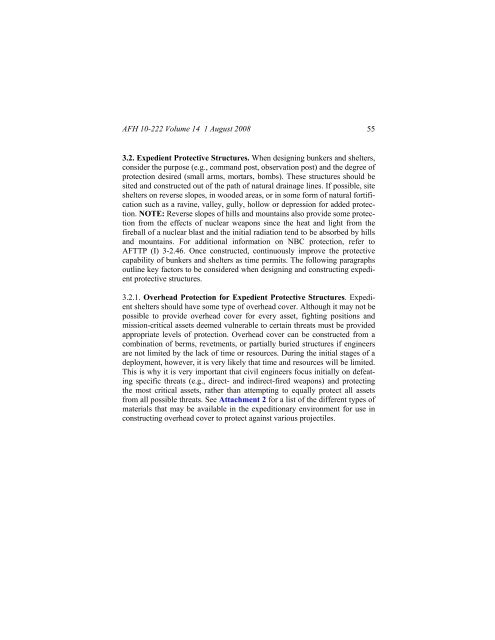Civil engineer guide to fighting positions, shelters, obstacles
Civil engineer guide to fighting positions, shelters, obstacles
Civil engineer guide to fighting positions, shelters, obstacles
You also want an ePaper? Increase the reach of your titles
YUMPU automatically turns print PDFs into web optimized ePapers that Google loves.
AFH 10-222 Volume 14 1 August 2008 55<br />
3.2. Expedient Protective Structures. When designing bunkers and <strong>shelters</strong>,<br />
consider the purpose (e.g., command post, observation post) and the degree of<br />
protection desired (small arms, mortars, bombs). These structures should be<br />
sited and constructed out of the path of natural drainage lines. If possible, site<br />
<strong>shelters</strong> on reverse slopes, in wooded areas, or in some form of natural fortification<br />
such as a ravine, valley, gully, hollow or depression for added protection.<br />
NOTE: Reverse slopes of hills and mountains also provide some protection<br />
from the effects of nuclear weapons since the heat and light from the<br />
fireball of a nuclear blast and the initial radiation tend <strong>to</strong> be absorbed by hills<br />
and mountains. For additional information on NBC protection, refer <strong>to</strong><br />
AFTTP (I) 3-2.46. Once constructed, continuously improve the protective<br />
capability of bunkers and <strong>shelters</strong> as time permits. The following paragraphs<br />
outline key fac<strong>to</strong>rs <strong>to</strong> be considered when designing and constructing expedient<br />
protective structures.<br />
3.2.1. Overhead Protection for Expedient Protective Structures. Expedient<br />
<strong>shelters</strong> should have some type of overhead cover. Although it may not be<br />
possible <strong>to</strong> provide overhead cover for every asset, <strong>fighting</strong> <strong>positions</strong> and<br />
mission-critical assets deemed vulnerable <strong>to</strong> certain threats must be provided<br />
appropriate levels of protection. Overhead cover can be constructed from a<br />
combination of berms, revetments, or partially buried structures if <strong>engineer</strong>s<br />
are not limited by the lack of time or resources. During the initial stages of a<br />
deployment, however, it is very likely that time and resources will be limited.<br />
This is why it is very important that civil <strong>engineer</strong>s focus initially on defeating<br />
specific threats (e.g., direct- and indirect-fired weapons) and protecting<br />
the most critical assets, rather than attempting <strong>to</strong> equally protect all assets<br />
from all possible threats. See Attachment 2 for a list of the different types of<br />
materials that may be available in the expeditionary environment for use in<br />
constructing overhead cover <strong>to</strong> protect against various projectiles.
















